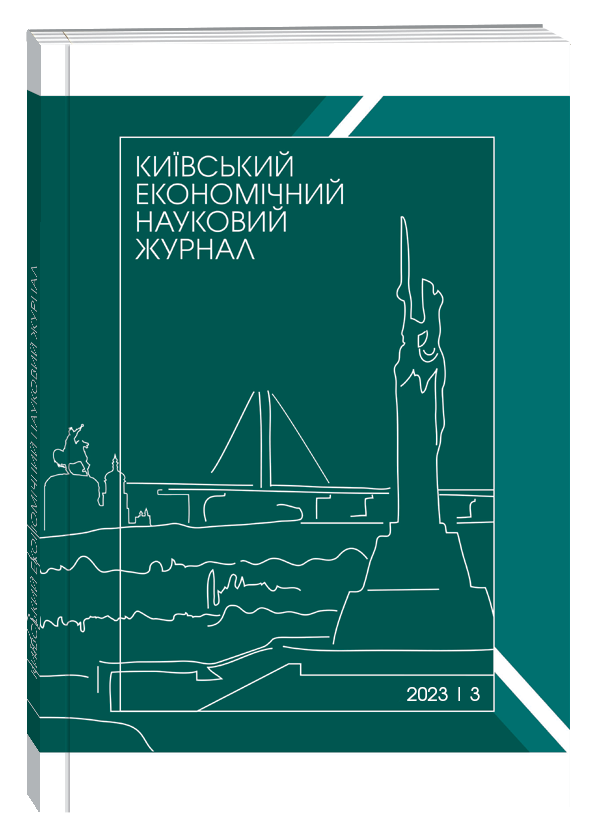A CONSENSUS APPROACH TO THE RECOVERY OF THE EUROPEAN ECONOMY AFTER WORLD WAR II
Abstract
Objective. The article analyzes the effectiveness of economic recovery programs in European countries after World War II. The change in geopolitics is characterized, while special attention is paid to the difference between the recovery of the economy after the Second World War and the post-war recovery after the First World War, namely: the reorientation from the reparation basis to the restructuring of the economies of European countries. Methods. The method of systematic analysis and synthesis was used to study the developments of domestic and foreign researchers in certain measures used for the post-war recovery of the European economy. Economic-statistical, comparative and graphic methods were used to assess the state of the economy of European countries in the post-war period. Results. It was determined that a significant role was played by aid in the form of targeted grants, the transfer of equipment and technologies from the USA. The distribution of aid according to the Marshall Plan was analyzed, its disproportionality was noted due to the distribution depending on the number of the population in the countries. It is emphasized that the Keynesian approach to the economic order became the key to the successful post-war recovery of European economies. That is, the basis was a consensus between economic policy, society and power structures. The result of such a compromise was the period that was called the «golden age of capitalism»: the growth of GDP, GNP, intra-European trade, etc. Also, the change in the economic policy of European countries prompted them to form a coalition to solve energy, economic, political and other issues. The scientific novelty lies in the defined consensus approach to the post-war recovery of the economy, which assigns a significant role to government participation in demand management, ensuring a balance between demand and production. The social compromise consisted in the fact that the population of the countries believed in recovery through joint efforts, the period was characterized by a low level of unemployment. Practical significance. The analysis of the economies of the post-war period made it possible to develop recommendations for the post-war recovery of Ukraine. The main tools of the consensus approach for the successful recovery of Ukraine have been determined: economic liberalization, creation of a large number of jobs, export orientation, improvement of investment attractiveness.
References
Бородіна О.А., Ляшенко В.І. Повоєнне відновлення економіки: світовий досвід та спроба його адаптації для України. Вісник економічної науки України. 2022. № 1(42). С. 121–134.
Підоричева І. Післявоєнне відновлення Європи: досвід та уроки для України. Журнал європейської економіки. 2022. Т. 21. № 2 (81). С. 190–207.
Серьогіна Д.О., Жовтяк Г.А., Базецька Г.І. Економічна реконструкція: вплив Другої світової війни на післявоєнне економічне зростання. Економіка та управління національним господарством. 2023. Вип. 71. С. 93–97.
Bretton Woods-GATT. URL: https://history.state.gov/milestones/1937-1945/bretton-woods (дата звернення: 29.09.2023).
Crafts N., Toniolo G. Postwar Growth : an Overview. Economic Growth in Europe since 1945. Cambridge : Cambridge University Press, 1996. 628 p.
Eichengreen B. Europe’s Post-war Recovery. Cambridge : Cambridge University Press, 1995. 368 p.
Irwin A.D. The GATT’S Contribution to Economic Recovery in Post-war Western Europe. URL: https://www.federalreserve.gov/pubs/ifdp/1993/442/ifdp442.pdf (дата звернення: 04.10.2023).
Keynes J.M. The General Theory of Employment, Interest, and Money. India : Atlantic Publishers & Dist, 2016. 400 p.
Marshall Plan. URL: https://history.state.gov/milestones/1945-1952/marshall-plan (дата звернення: 29.09.2023).
Pidorycheva I.Yu., Antoniuk V.P. Modern development trends and prospects for innovation in the technology-intensive sectors of Ukraine’s industry. Science and Innovation. 2022. № 18(1). Р. 3–19.
Post-World War II economic boom. URL: https://www.statista.com (дата звернення: 30.09.2023).
Przeworski A. Capitalism and Social Democracy. Cambridge : Cambridge University Press, 1985. 280 р.
Przeworski A. How many ways can be third? Social Democracy in Neoliberal Times: The Left and Economic Policy Since 1980. Oxford : Oxford University Press, 2001. рр. 312–333.
Schmitter Ph. C., Grote, J. R. The Corporatist Sisyphus: Past, Present and Future. EUI Working Paper SPS. 1997. № 97 (4). 22 р.
Tumlir J., La Haye L. The Two Attempts at European Economic Reconstruction After 1945. Economic Reconstruction in Europe: The Reintegration of Western Germany: A Symposium (September 1981). З. 367-389.
Borodina O.A., Lyashenko V.I. (2022) Post-War Economic Recovery: World Experience and Attempt to Adapt it for Ukraine. Bulletin of Economic Science of Ukraine, no. 1 (42), рр. 121–134.
Podorycheva I. (2022) Postwar recovery of Europe: experience and lessons for Ukraine. Journal of European Economics, vol. 21, no. 2 (81), pp. 190–207.
Serogina D., Zhovtyak H., Bazetska H. (2023) Economic Reconstruction: The Impact Of The Second World War On Post-War Economic Growth. Economics and management of the national economy, no. 71, pp. 93–97.
Bretton Woods-GATT. Available at: https://history.state.gov/milestones/1937-1945/bretton-woods
Crafts N., Toniolo G. (1996) Postwar Growth : an Overview. Economic Growth in Europe since 1945. Cambridge: Cambridge University Press, 628 p.
Eichengreen B. (1995) Europe’s Post-war Recovery. Cambridge: Cambridge University Press, 368 p.
Irwin A. D. The GATT’S Contribution to Economic Recovery in Post-war Western Europe. Available at: https://www.federalreserve.gov/pubs/ifdp/1993/442/ifdp442.pdf
Keynes J. M. (2016) The General Theory of Employment, Interest, and Money. India: Atlantic Publishers & Dist, 400 p.
Marshall Plan. Available at: https://history.state.gov/milestones/1945-1952/marshall-plan
Pidorycheva I. Yu., Antoniuk V. P. (2022) Modern development trends and prospects for innovation in the technology-intensive sectors of Ukraine’s industry. Science and Innovation, no. 18(1), pp. 3–19.
Post-World War II economic boom. Available at: https://www.statista.com
Przeworski A. (1985) Capitalism and Social Democracy. Cambridge: Cambridge University Press, 280 р.
Przeworski A. (2001) How many ways can be third? Social Democracy in Neoliberal Times: The Left and Economic Policy Since 1980. Oxford: Oxford University Press, рр. 312–333.
Schmitter Ph. C., Grote J. R. (1997) The Corporatist Sisyphus: Past, Present and Future. EUI Working Paper SPS, no. 97 (4), 22 р.
Tumlir J., La Haye L. (1981) The Two Attempts at European Economic Reconstruction After 1945. Economic Reconstruction in Europe: The Reintegration of Western Germany: A Symposium, pp. 367–389.


